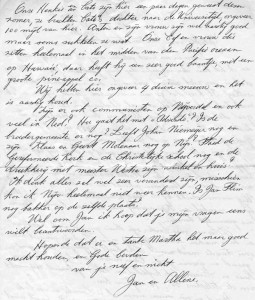 A brief is a letter. Brieven are a great source of information. Personal letters written by emigrants to their family back home can give you a great idea of what their pioneering life was like.
A brief is a letter. Brieven are a great source of information. Personal letters written by emigrants to their family back home can give you a great idea of what their pioneering life was like.
I’ve also found valuable information in official correspondence, for example in the correspondence of the municipality where my ancestor lived. In municipal correspondence, I’ve found letters about people who were sent to the pauper colonies or an insane asylum, and appointments of city officials like of police constables and clerks.
For an example of a personal letter, read the article about Jan Antonie Boerrigter, which includes a letter that he sent from Nebraska in 1957.


I have nearly 25 years’ worth of letters from a great aunt who lived in the Netherlands, all written it Dutch. We started corresponding after she visited Canada when I was 12. I would write to her in English; she’d write in Dutch. Her children translated my letters for her; my dad would read hers to me. Sometimes it was a hard task for my father, as he came to Canada having only done his first year of school (if that) when he came to Canada. When I moved away from home, I kept up the correspondence with my aunt, but had to translate on my own. All I had was a Dutch-English dictionary – no Google Translate back then! It was particularly tricky translating idioms. As well, my aunt’s letters often used older spelling and grammar, making it harder to look things up. I know there’s a ton of genealogical information in those letters, but it’s gonna be a lot of work on a long to-do list. I did have the wisdom, in her later years, to specifically ask her some genealogy questions. I even went through the pains of creating a fill-in-the-blanks chart for her, in Dutch. She was helpful, but told me I was wasting my time. It was the only harsh or negative thing she ever said to me in all those letters!
How wonderful to correspond for so long! I am still in touch with my great-aunt in the US, who emigrated in the 1940s. She probably still has all the postcards I sent when I went crisscrossing the country by train as a teenager (“tienertoer”). She still speaks Dutch so that was a lot easier.